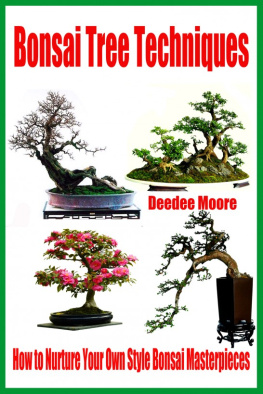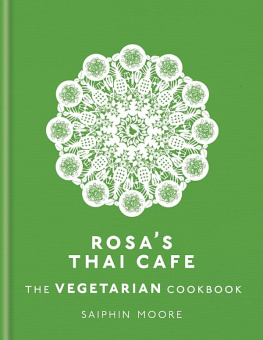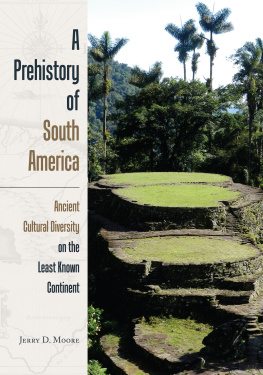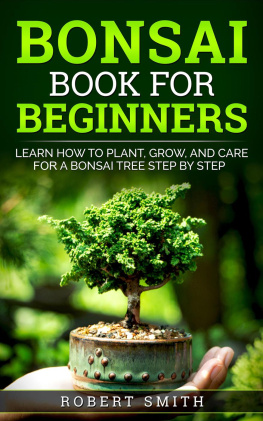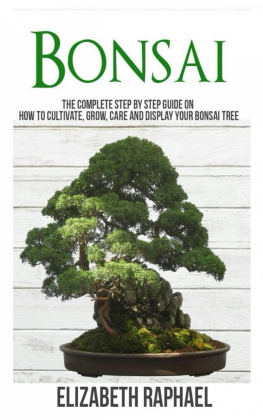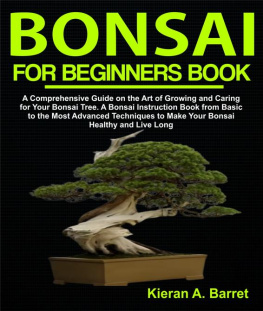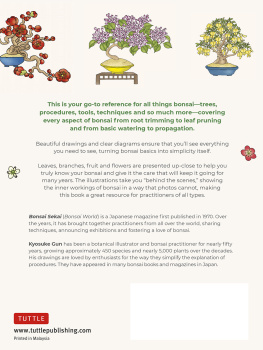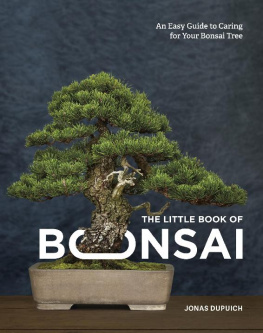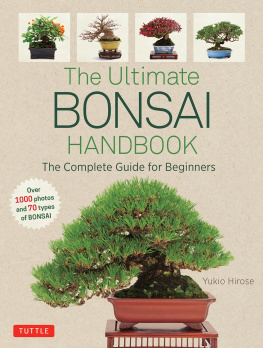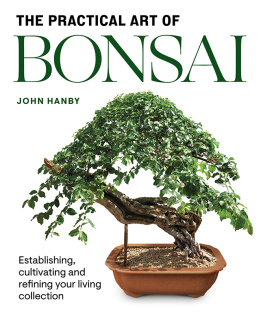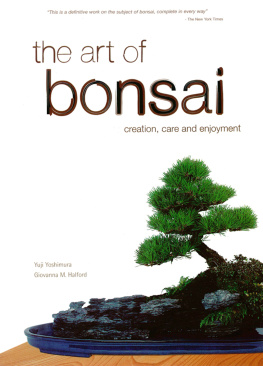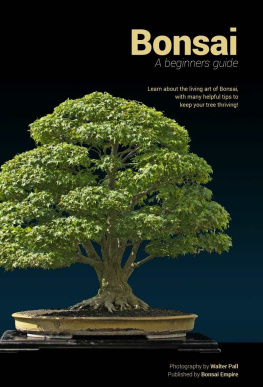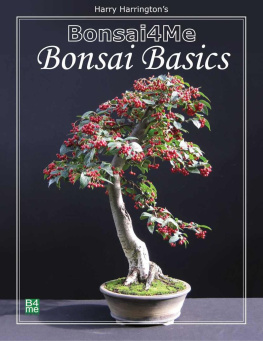Bonsai Tree Techniques - How to Nurture Your OwnStyle Bonsai Masterpieces
By Deedee Moore
Copyright 2016 by Deedee Moore
Smashwords Edition
Please ReadThis First
Terms of Use
This ebook is licensed for your personalenjoyment only. This ebook may not be re-sold or given away toother people. If you would like to share this book with anotherperson, please purchase an additional copy for each recipient. Ifyoure reading this book and did not purchase it, or it was notpurchased for your use only, then please return toSmashwords.comand purchase your own copy. Thank you for respecting the hard workof this author.
Disclaimer
The advice contained in this material might besuitable for everyone. The author got information from sourcesbelieved to be reliable and from personal experience, but does notimply nor offer any guarantee of accuracy.
The author, publisher and distributors nevergive legal, accounting, medical or any other type of professionaladvice. The reader must always seek those services from competentprofessionals that can review their own particularcircumstances.
The author, publisher and distributorsparticularly disclaim any liability, loss, or risk taken byindividuals who act on the information here. All readers mustaccept full responsibility for their use of this material.
Bonsai Tree Techniques - How to Nurture Your OwnStyle Bonsai Masterpieces
Tableof Contents
Introduction
Miniascape originated in China and has beendeveloping in China. It is China's ancient culture and theexcellent traditional art. It contains the literary and aesthetics,and combines plant cultivation, plant morphology, plant physiology,garden art and plant shaping art together. It is made from plants,rocks by the art processing to concentrate natural wonders. Youcould see flourishing woods, tall bamboo bushes and forest-cladmountains in a limited space, which is natural and beyond natureand that brings the viewer into a deep aesthetic mood.
Bonsai is the art of dwarfing trees or plantsand developing them into an aesthetically appealing shape bygrowing, pruning and training the trees into containers accordingto prescribed techniques.
I will introduce you to bonsai techniquesinclude wiring, pruning, carving, cutting, lifting root, shaping,styling, potting in details and provide rich skills on care andmaintenance including watering, fertilizing, temperature,increasing flowering and fruiting rates, repotting, bonsai pestsand diseases and so on. You will get the detailed knowledge to growyour own style masterpieces.
To Do a Good Job Must First Sharpen His Tools
To do good work must first sharpen his tools.
The discovery, selection and use of equipmentare the foundation of bonsai creation. Although, evaluating thequality of a bonsai lies not in what kind of material, also is notits size, but in its shaping and conception. But potted landscapeworks from creation to completion relying on certain equipment,which is also limited by the characteristics of the material. Goodequipment lays the foundation for good bonsai creation.
The focus is on the recognition of stones andbonsai production tools. The difficulty is the recognition ofstones.
The bonsai stones can be divided into twocategories:
One is the soft stone, which is soft, light,water absorption, producing young moss, easy processing; The otheris hard stone (also called a hard rock), which is hard, heavy,nonabsorbent, not easy processing.
Soft stones:
1. Pumice (Pumice stone)
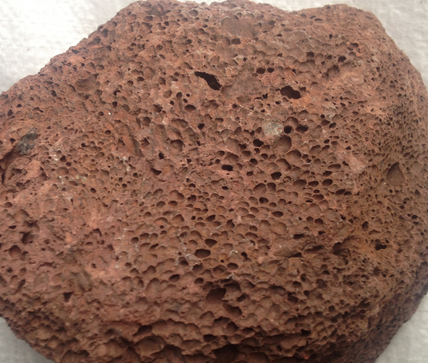
Pumice is also called float stone, because itcan float on the surface of the water. Pumice is volcanic rock.Pumice is white, grayish yellow, light grey, dark grey, blacketc
Soft hardness of pumice has great difference,most of the texture is soft; and the pores are variable in size.The pumice composition is sio2. Pumice with small pores can processand carve fine texture. For a big pore pumice is difficult to carvethe ideal fine texture.
Pumice is one of the commonly used materials ofbonsai. Pumice is light and soft, easy to processing, usingordinary wood saw, hand saw, hacksaw can cut the stone. Waterabsorption performance of pumice is good; as long as the suitabletemperature, humidity and sunshine, pumice will give birth to mossnaturally; some pumice can also grow small grass. The pumicefirmness is poorer, so not easy to make large bonsai, commonly usedto make the medium and small or miniature bonsai.
2. Sand stone
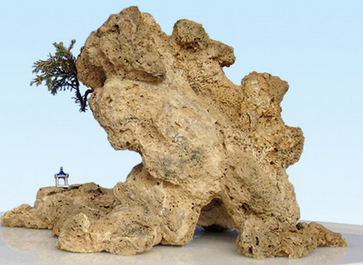
Sand stone is coagulation deposition of calciumcarbonate. According to the size of the sand grain, it is dividedinto rough sand stone and fine sand stone. The color and luster isdiffer, because producing area is different. There are yellow,beige, brown, etc...
Depending on different proportion of content ofthe sediment and calcium carbonate, sand stones are loose or hardand the quality of the materials is different too. Those containingmuch sediment are relatively loose with good water absorption, butare not strong; containing more calcium carbonate are hard, buthave poor water-absorbing quality.
Sand stone is one of the most commonly usedmaterials to make bonsai. Because sand stones water absorptionperformance is good, and has certain firmness, it is can be used tomake large or huge landscape bonsai. When the production of themain peak of the large and medium-sized landscape bonsai, youshould use hard sand stone which is not easily broken whentransportation; the soft texture, can do short hills, distantmountains, islands and rocky hills, etc. Sand stone easily growmoss, also easy to cultivate plants.
3. Reed tube stone
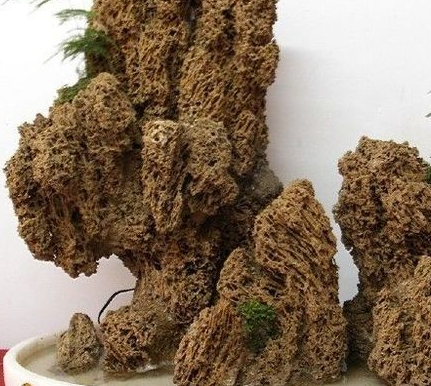
Reed tube stone has two types: thick and thin.The thick looks like a thin bamboo; the thin is such as a straw.Reed tube stone is the surface of calcareous sandstone which notonly containing sediment and calcium carbonate, but some plantresidues, such as trees, branches and leaves, reeds, straws, etc.With these organic substances mixed in it, thus form differentdegree and crisscrossed tubular structure. Reed tube stone has thecolor of yellow, black and yellow, white, etc. It has natural formwith marvelous peaks and wonderful caves.
Reed tube stone is one of the most commonly usedmaterials to make bonsai or pile up garden rockery. The stone isabsorbent of water, and is suitable for moss and small plants togrow, so get the favor of the masses of bonsai enthusiasts.
4. Bryozoatum
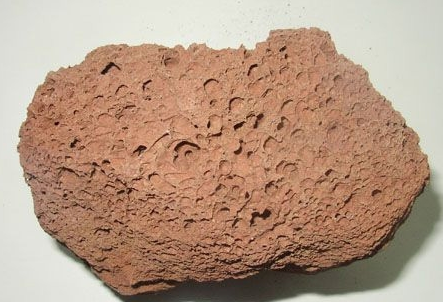
Bryozoatum is also called coral rock. Scientificname is hexacorallia. Bryozoatum is the body of hexacorallia whichaccumulates and becomes fossils, and main ingredients arecalcareous with thick and fine types. The fine type can float onthe surface of the water. Tubule diameter is of 0.3 cm, easy tocarve processing; thick tube diameter of 0.7 cm, which shape andtexture are beautiful, but it is hard and difficult to carve.
Bryozoatum is generally white with good waterabsorption, can be processed into a variety of styles of bonsai.Because there is no too big bryozoatum, it is commonly used toproduce medium and small bonsai. Bryozoatum contains much salt, soit should be soaked for a period of time, and repeatedly washed toremove the salt, just for planting vegetation, growing moss.

